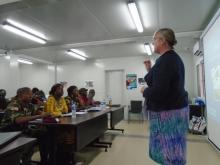Liberia conducts integrated risk profiling of public health threats with WHO support
Liberia’s health system is progressively recovering from the unprecedented Ebola Virus Disease (EVD) outbreak that tested its fragility. The recovery process is guided by the Investment Plan for building a Resilient Health System that prioritizes among others emergency preparedness and response as well as the fit-for-purpose, productive and motivated health workforce and health infrastructure.
Health preparedness and response requires a systematic assessment of the risks and threats that the country faces. This was the purpose of the integrated public health risk profiling conducted recently by the Ministry of Health with support from the World Health Organization (WHO). This exercise is expected to significantly contribute to the Joint External Evaluation (JEE) process and also review of the Emergency Preparedness and Response Plan.
The two-day activity conducted at the MOH Emergency and Operations Center (EOC) in Monrovia also provided a systematic, transparent and evidence-based approach to identify and classify priority risks as well as guiding the implementation of a comprehensive and strategic risk profiling to inform review of the preparedness and response plans. Participants identified potential hazards, assessed national preparedness and readiness, and defined mitigating factors. The risk profiling workshop brought together stakeholders from government Ministries, UN agencies and partners under the multi-sectoral approach that worked so well during the Ebola response.
These stakeholders contribute tremendously to the prevention, preparedness, response, mitigation and recovery from emergencies.
During the workshop, the participants used the Strategic Tool for Assessing Risks (STAR) developed by WHO, to guide discussions, reflections, analysis and to capture data on the public health threats and risks. The STAR tool enables countries to conduct an evidence based risk assessment in a comparable, replicable and defensible manner. The tool highlights priorities for the development of contingency plans and specific responses, and also outlines the potential needs to enhance national capacity in terms of preparedness and response.
The level of risk is determined as a product of the likelihood of it occurring and its impact on the health care system. The risks identified in the workshop require a coordinated response. Therefore a comprehensive list of events for which the health sector should be prepared was developed. This list will be used by the Ministry of Health for integration into the disaster risk management planning.
Finally, WHO recommends that the health risk profile using the STAR tool be reviewed and updated regularly as the country continues to build capacity and systems to manage risks.
___________________________________________________
For more Information contact:
Technical: Dr Peter Clement email: clementp [at] who.int (clementp[at]who[dot]int )
Communication: Luwaga Liliane, emailluwagal [at] who.int ( luwagal[at]who[dot]int)





